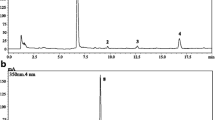Abstract
The rhizomes of the Zingiberaceae family are a vegetable widely used in many Asian countries, and their medicinal functions have been broadly discussed and accepted in many traditional recipes. In this study, 18 species of five genus of Zingiberaceae plants from Taiwan area were collected and analyzed for their functional properties. Methanolic extracts of the plants were analyzed for their total phenol compounds, α,α-diphenyl-β-picrylhydrazyl (DPPH) scavenging activity, and reducing power. Antimicrobial activity of these samples was also determined. The results showed that the total phenol compounds of the Alpinia genus averaged 17, 30 mg/g for Curcumas, and the highest, 36.5 mg/g for Vanoverberghia sasakiana. Antioxidant performances were best observed in Vanoverberghia and Hedychium, both 89%, and DPPH scavenging activity followed similar trends. Particularly, Zingiber oligophyllum, considered as a traditional medicinal plant used in Taiwan exhibited low DPPH scavenging activity and reducing power. Most Zingiberaceae plant extracts exhibited antimicrobial activity against all tested food microorganisms. Hedychium and Vanoverberghia, did not show antimicrobial activities on Escherichia coli and Vibrio parahaemolyticus. This study is a positive demonstration of the utility of screening Taiwan’s endemic Zingiberaceous plants for their food and medicinal uses.

Similar content being viewed by others
References
Wu TL, Larsen K (2000) Zingiberaceae. Flora of China 24:322–377
Miquel J, Bernd A, Sempere JM, Diaz-Alperi J, Ramírez A (2002) The curcuma antioxidants: pharmacological effects and prospects for future clinical use. A review. Arch Gerontol Geriatrics 34:37–46
Ammon HPT (1991) Pharmacology of Curcuma longa. Planta Med 57:1–7
Charles V, Charles SX (1992) The use and efficacy of Azadirachta indica ADR (‘Neem’) and Curcuma longa (‘Turmeric’) in scabies. A pilot study. Trop Geogr Med 44:178–181
Skrzypezac-Jankun E, McCabe NP, Selman SH, Jankun J (2000) Curcumin inhibits lipoxygenase by binding to its central cavity: theoretical and X-ray evidence. Int J Mol Med 6:521–526
Habsah M, Amran M, Mackeen MM, Lajis NH, Kikuzaki H, Nakatani H, Rahman A, Ghafar A, Ali AM (2000) Screening of Zingiberaceae extracts for antimicrobial and antioxidant activities. J Ethnopharmacol 72:403–410
Mau JL, Eric Lai YC, Wang NP, Chen CC, Chang CH, Chyau CC (2003) Composition and antioxidant activity of the essential oil from Curcuma zedoaria. Food Chem 82:583–591
Suhaj M (2006) Spice antioxidants isolation and their antiradical activity: a review. J Food Compost Anal 19:31–537
Sirat HM (1994) Study on the terpenoids of Zingiber ottensi. Planta Med 60:497
Sirat HM, Liamen MR (1995) Chemical constituents of Alpinia purpurata. Pertanika J Sci Technol 3:67–71
Sirat HM, Rahman AA, Itokawa H, Morita H (1996) Constituents of the rhizomes of two Alpinia species of Malaysia. Planta Med 62:188–189
Yang YP (2002) Zingiberaceae. In: Yang YP, Liu HY, Lin TP (eds) Manual of Taiwan vascular plants. Council of Agriculture, Republic of China, pp 202–209
Duarte-Almeida JM, Novoa AV, Linares AF, Lajolo FM, Genovese MI (2006) Antioxidant activity of phenolics compounds from sugar cane (Saccharum officinarum L.) juice. Plant Foods Hum Nutr 61:187–192
Miller NJ, Rice-Evans CA (1997) The relative contributions of ascorbic acid and phenolic antioxidants to the total antioxidant activity of orange and apple fruit juices and blackcurrant drink. Food Chem 60:331–337
Arnao MB, Cano A, Acosta M (2001) The hydrophilic and lipophilic contribution to total antioxidant activity. Food Chem 73:239–244
Shimada K, Fujikawa K, Yahara K, Nakamura T (1992) Antioxidative properties of xanthan on the autooxidation of soybean oil in cyclodextrin. J Agric Food Chem 40:945–948
Duh PD, Yen GC (1997) Antioxidative activity of three herbal water extracts. Food Chem 60:639–645
Gülçin I, Küfrevio ÖI, Oktay M, Büyükokuroglu ME (2004) Antioxidant, antimicrobial, antiulcer and analgesic activities of nettle (Urtica dioica L.). J Ethnopharmacol 90:205–215
Wilson B, Abraham G, Manju VS, Mathew M, Vimala B, Sundaresan S, Nambisan S (2005) Ethnopharmacological communication—antimicrobial activity of Curcuma zedoaria and Curcuma malabarica tubers. J Ethnopharmacol 99:147–151
Hsu CL, Chen WL, Weng YM, Tseng CY (2003) Chemical composition, physical properties, and antioxidant activities of yam flours as affected by different drying methods. Food Chem 83:85–92
Harman D (1986) Free radical theory of aging: role of free radicals in the origination and evolution of life, aging and disease processes. In: Johnson JE, Jr Walford R, Harman D, Miquel J (eds) Free radicals, aging and degenerative diseases. Alan R. Liss, New York, pp 3–49
Bhandari U, Raman K, Pillai KK (2005) Effect of ethanolic extract of Zingiber officinale on dyslipidaemia in diabetic rats. J Ethnopharmacol 97:227–230
Bernd A, Theilig C, Kippenberger S, Ramírez-Bosca A, Podda M, Díaz J, Miquel J, Kaufmann R (1997) An extract of Curcuma longa exerts anti-oxidative, anti-inflammatory and antiproliferative effects on human keratinocytes in vitro. J Invest Dermatol 109:460
Funakoshi H, Ohashi H (2000) Vanoverberghia sasakiana H. Funak. & H. Ohashi (Zingiberaceae), a new species and a new generic record for the flora of Taiwan. Taiwania 45:270–275
Acknowledgment
The authors would like to thank Taiwan Endemic Species Research Institute, Council of Agriculture, Republic of China for the donation of ginger samples. Assistance of local growers from different county in species collection were also very much appreciated.
Author information
Authors and Affiliations
Corresponding author
Rights and permissions
About this article
Cite this article
Chen, IN., Chang, CC., Ng, CC. et al. Antioxidant and Antimicrobial Activity of Zingiberaceae Plants in Taiwan. Plant Foods Hum Nutr 63, 15–20 (2008). https://doi.org/10.1007/s11130-007-0063-7
Received:
Accepted:
Published:
Issue Date:
DOI: https://doi.org/10.1007/s11130-007-0063-7




